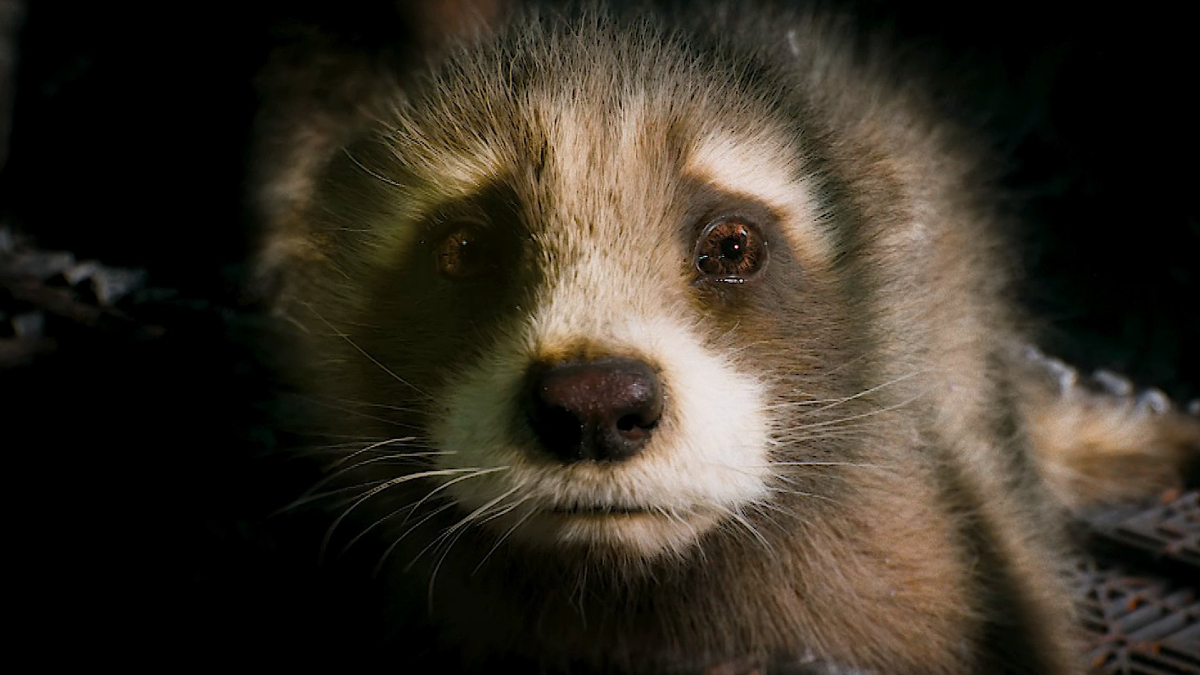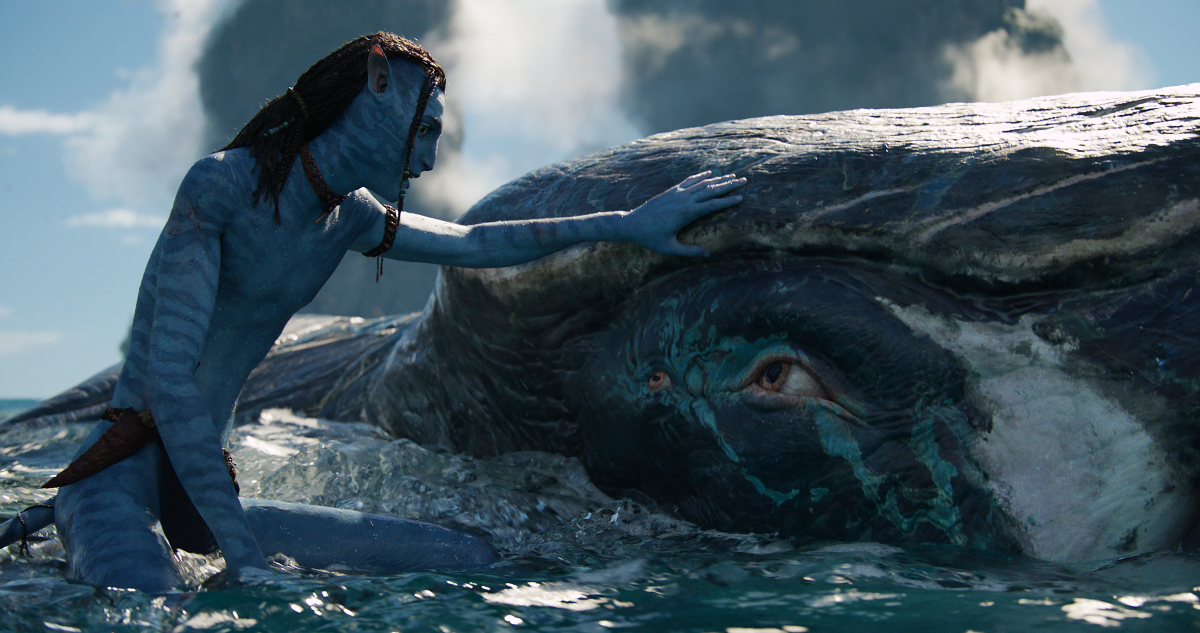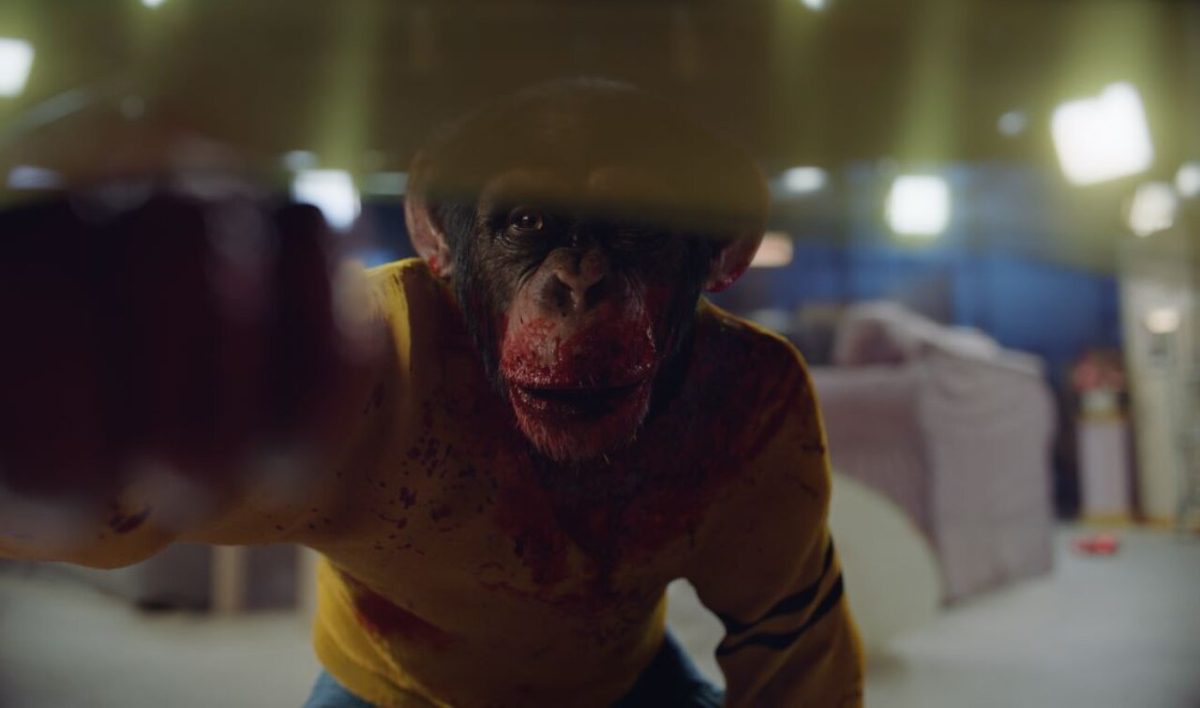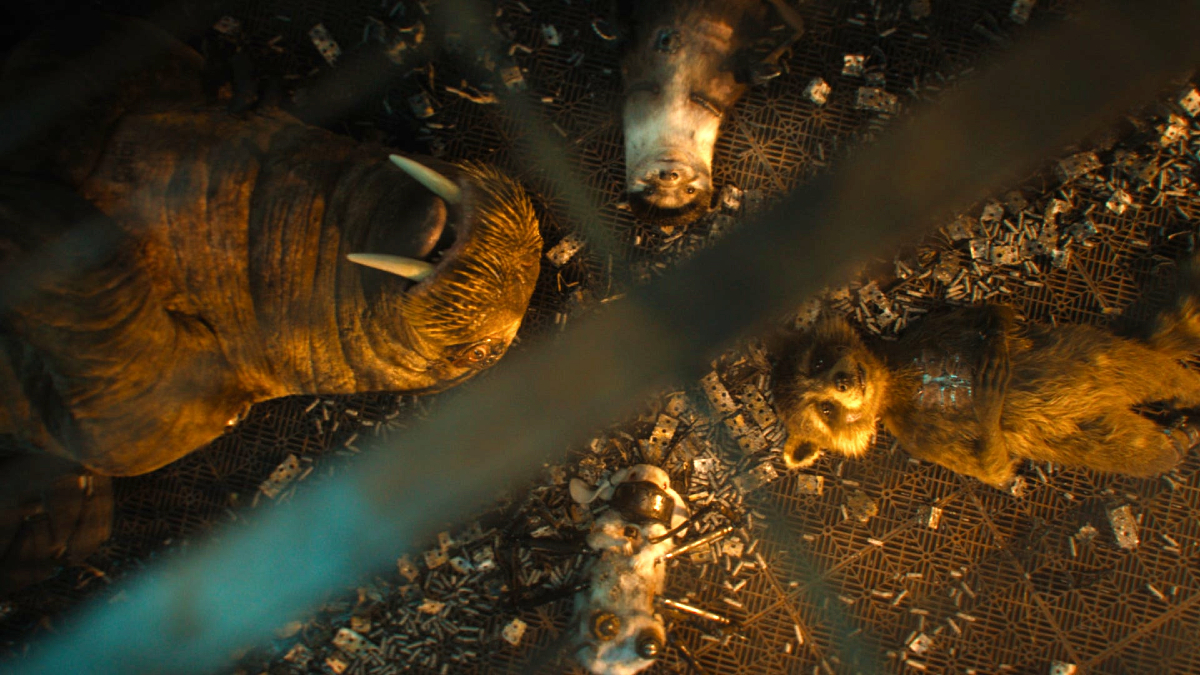‘Guardians of the Galaxy Vol. 3’ Joins Recent Blockbusters in Confronting Animal Cruelty

The trailers for Marvel’s Guardians of the Galaxy Vol. 3 serve as a glaring warning to viewers who have a hard time watching depictions of animal abuse. It was clear from the first teaser that the conclusion to James Gunn’s intergalactic superhero trilogy would finally explore Rocket’s traumatic origin story, which involves a great deal of physical and mental torture. Gunn delivers on this painful promise in the Guardians sequel, the latest blockbuster—coming right on the heels of Jordan Peele’s Nope and James Cameron’s Avatar: The Way of Water—to bring speciesism back to mainstream discourse.
In a motley crew of unlikely superheroes with chips on their shoulders, Rocket—the tough guy raccoon voiced by Bradley Cooper—has the biggest chip of them all. Not that trauma is a pissing contest, but enduring physical torture at the hands of a madman obsessed with evolutionary perfection leaves profound psychic scars. Nebula (Karen Gillan) recognizes in Rocket the amorphous shape of her own pain, which was similarly tortured into existence by a paternal figure who thought himself God. Guardians 3 is punctuated by scenes almost too horrible to think about, let alone watch. Gunn uses body horror effectively throughout the film, from the sponge and sinew of Orgocorp HQ—a structure made entirely of bio-organic materials—to the harrowing scenes of animal cruelty.
Guardians of the Galaxy Vol. 3 begins with a hand reaching into a cage filled with baby raccoons and taking the tiny Rocket for the first of many experiments conducted by the High Evolutionary (Chukwudi Iwuji). We don’t see the surgeries explicitly, but we hear the terrible sounds of steel cutting and sawing as his legs thrash. Metallic implants are forced on and into Rocket’s body. He’s still bleeding from an incision line on his head when he’s sent to a dirty cage with other mutilated animals from his test group. Later, they adopt names to better prepare for the freedom they’ve been falsely promised: Lylla is a gentle otter whose limbs have been replaced with metal blades. Floor is a small, excitable bunny whose limbs have been amputated, her spine affixed with spider-like prosthetics, and her mouth covered with a heavy metal contraption. Teefs is a kindly walrus whose eyes have been permanently pried open and has large metal wheels attached to his sides.
Such cruelty is unimaginable, which is why we must see it imagined. But Gunn mercifully spares his audience from witnessing the worst of Rocket’s many physical traumas when his friends watch archival footage of the High Evolutionary opening Rocket’s skull and meddling with his brain. The audio—and the reactions from Nebula, Peter, and the gang—tell us everything we need to know. Rocket was awake. He felt everything.
These scenes are visceral provocations, each pointedly rejecting the notion that meaningful change can be achieved through impassioned (and more palatable) pleas. To put it another way: Free Willy is calling for thoughts and prayers, while Guardians 3 is demanding sweeping reforms. Merely suggesting that some brutality has occurred does a disservice to the audience. It encourages us to continue perceiving violence as an abstract concept. Which is why it’s so unusual to see animal abuse presented this way in a Disney film.
Stranger still, Guardians 3 isn’t even the first blockbuster released by Disney in the past year that confronts speciesism. Avatar: The Way of Water, though inherently and deeply flawed in its perspective on colonialism, ultimately challenges its audience’s perception of the lived experiences of other species. In the film, operatives from the Resources Development Administration—a powerful conglomerate given carte blanche by the interplanetary government—are systematically hunting and killing the tulkun, a whale-like species of marine mammal that live in the oceans of Pandora. Some of the most upsetting scenes in the Avatar sequel involve the slaughter of the tulkun, who are being killed so that the RDA can harvest a neurochemical from their brains that reverses human aging.

These scenes feel the most accomplished of any in the Avatar films because they’re the most recognizable. Whaling has existed for millennia, and although commercial whaling has been banned throughout most of the world, a few countries still hunt and kill thousands of whales every year for profit. Seeing the tulkun slaughtered in The Way of Water calls to mind haunting documentaries like The Cove and Blackfish, which shine a harsh light on the commodification, abuse, and mass killing of marine mammals. We can’t communicate with our whales the way the Metkayina clan communicate with the tulkun in The Way of Water, but decades of research has proven that whales and dolphins (as well as octopuses) are highly intelligent beings capable of thinking, reasoning, and feeling. While some viewers find the tulkun hunting scenes in The Way of Water to be excessive, they are relatively tame when compared to the version that plays out in our oceans.
While graphic depictions of animal abuse aren’t generally necessary, thoughtful representation that considers the perspectives of both the subject and the viewer is imperative, and should elicit discomfort. Any inclusion of explicit violence or trauma should give the viewer emotional context and offer an anchor to which we can affix our empathy. In The Way of Water, we immediately identify with Payakan, the outcast tulkun, when he communicates with the teen Lo’ak; it’s startling when the captions appear on screen, translating Payakan’s first expression. “I can’t talk about it,” he says when Lo’ak asks why he was outcast. “It’s too painful.” Instead, he shows Lo’ak what he can’t bring himself to describe: When his mother was killed by the RDA, Payakan led a retaliatory attack in defiance of the tulkun’s strict pacifist philosophy, resulting in the deaths of many tulkun and Na’vi. Payakan felt he had no other choice.
Jordan Peele’s Nope interrogates our relationship with other species through the lens of spectacle and human utility. OJ (Daniel Kaluuya)’s capacity for trying to understand his horses rather than projecting human qualities onto them becomes useful when a mysterious alien life form begins appearing over his ranch, indiscriminately consuming everything—and everyone—in its path. Nope contemplates speciesism by pointing out our tendency to treat animals (and other beings) inhumanely based on the false assumption that animals are less intelligent, when the reality is that they simply think differently. Peele takes a more direct approach for the scenes involving Gordy, the trained chimpanzee who violently attacks his co-stars on the set of a ’90s sitcom when he’s triggered by a popped balloon. The Gordy incident is intensely visceral, as if it’s hitting a primitive empathetic nerve. Here, Peele deliberately obfuscates the worst of the violence: we see a child’s legs on the floor, the top of her body hidden behind a couch as the chimpanzee maims her face. We hear the chimpanzee’s grunts and hoots, which could be mistaken for playful, yet we recognize a horrible lifelessness in the child’s limbs as they’re jostled by the chimp’s attack. The hoots become more plaintive and inquisitive, as if Gordy doesn’t understand why the child has stopped moving.

What makes these scenes in Nope particularly hard to watch despite much of the violence occurring off-camera is the understanding that this was an avoidable tragedy. Gordy isn’t to blame for his outburst, which is ultimately the result of a series of willful misunderstandings and plain hubris. The kind of hubris that leads people to believe that humans are the superior species and that we can shape animal behavior and force them to serve our interests; that animals have no interests of their own and can be subjugated—violently—without consequence.
It’s worth noting that the Gordy incident in Nope, like the whaling in The Way of Water and the animal abuse in Guardians of the Galaxy Vol. 3, has its basis in reality. While there are several recorded instances of primates attacking people after years of peaceful domestication, Peele was inspired specifically by the story of Charla Nash, who was brutally mauled by Travis, a friend’s chimpanzee.
Like the child actor in Nope, the High Evolutionary survives when he’s similarly mauled by Rocket. This scene in Guardians 3 is a little more graphic than the one in Nope, but by this point in the film, Rocket’s story has demonstrated its awful necessity. The High Evolutionary’s cruelty goes beyond physical abuse and, as is true of many abusive relationships, is deeply intertwined with emotional abuse. He presents as a paternal figure and uses this dynamic to manipulate Rocket, coaxing him to comply with false promises of a beautiful life for Rocket and the other creatures in his dubious utopia. When the High Evolutionary drops the charade and Rocket’s friends are killed during a desperate escape attempt, Rocket viciously retaliates. It’s an act of violence that is simultaneously horrible and justifiable, and it’s made all the more visceral by the fact that Rocket—like Payakan and Gordy—has no other choice.
The High Evolutionary’s horrific abuse isn’t very far removed from the ways in which humans treat animals, be it for cosmetic testing, scientific research, factory farming, or in our own homes. Guardians 3 heightens this terrible reality with science fiction, but the setting—the villain’s supposedly utopian Counter-Earth—is one we’re meant to recognize. On our Earth, we often ascribe human qualities to animals to make sense of their behaviors, reinforcing the misguided belief that we can understand and communicate with them. This hubris often leads to senseless tragedy: Travis, the chimpanzee who mauled Charla Nash, seemingly unprovoked; Mantacore, the tiger who attacked magician Roy Horn during a Siegfried & Roy show; and Tilikum, the orca who drowned trainer Dawn Brancheau during a performance at SeaWorld, and who was previously involved with two other deaths.
Each of these animals was given a name, a seemingly innocuous custom that signifies domestication and ownership. For animals, naming confers a status of personhood never meant to be wholly recognized, which seems particularly cruel. In Guardians 3, the High Evolutionary takes the anthropomorphization of animals a step further by forcing them through a torturous evolutionary “jump” which gives them the ability to speak as humans do. (Rocket’s first word is “hurts.”) That the High Evolutionary can communicate with his captives and that they are able to verbally express their pain makes his abuse crueler still.

But Rocket and his friends—Lylla, Floor, and Teefs—differ from their real world counterparts in one incredibly meaningful way. They weren’t assigned these names. They chose them.
Animal rights philosophy has existed longer than commercial whaling, but our concerns have waned as our reliance on animal products has grown. Meat production has increased fourfold in the past 50 years. Though vegetarianism and veganism have become more commonplace, meat consumption is expected to increase exponentially in the coming decades; the UN estimates a 76% rise in meat consumption by 2050. While the federal Animal Welfare Act regulates the treatment of animals for “research, teaching, testing, exhibition, transport, and by dealers,” there are no federal welfare laws concerning the treatment of “food animals” in factories and on farms. And, as it turns out, the Animal Welfare Act isn’t particularly effective at preventing cruel treatment.
In movies and on TV, we watch the fictional stories of daring dogs, charming cats, and adventurous animals across the world. Babe the pig inspires a farmer to rethink his perception of animals in terms of their usefulness. An orca befriends a troubled kid, who decides to liberate him from captivity. These stories are meant to inspire us to reconsider how we view animals, but they are couched in fantasy, making it easier to view animals’ feelings as little more than that. In real life, whales and elephants mourn the loss of group members. Octopuses are known to be mischievous and even play pranks. Fish can feel pain. Even bees, according to a recent study, have feelings.
But in our modern society, driven as it is by convenience and access, we prefer not to think about how the fulfillment of our needs and desires impacts the lives of others. Which is why we don’t view animals as living individuals with self interests. We see them instead as resources, like trees and lakes and mineral deposits, or as property, like a home or a blender or a television. Animal rights has become a fringe progressive issue; even the left thinks of it as a low priority—we can’t provide access to basic healthcare and homes for the most vulnerable people in our communities, let alone ensure the welfare of an animal.
I’m not naive enough to believe that Disney studio executives were thinking about any of this when they released Guardians of the Galaxy Vol. 3 or Avatar: The Way of Water, or when Universal released Nope. Yet through some unholy alchemy of capitalist greed and art, three of the biggest blockbusters of the past year also happen to be some of the best filmmaking about our relationship with other species. And it’s impossible to talk about these movies without acknowledging the uncomfortable reality that makes them so effective at eliciting empathy.
(featured image: Walt Disney Studios Motion Pictures)
Have a tip we should know? [email protected]
